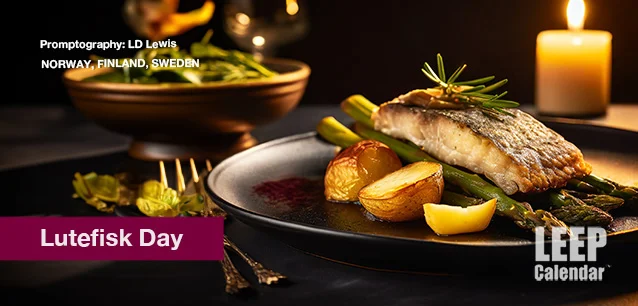 AD
AD
Today is: August 09
Scroll to explore events active on this date.
LEEP INK FEATURES

August? Absolutely!
In August, we live through the Dog Days of Summer. It's hot and often humid, and those who can leave for better climates do. Down south, winter is in full force. August is also known as "the ...

In The Heat of July: July 2025 Events
Is it hot enough (or cold enough if you're below the equator) for you yet? There is actually a day for that! Like every month, I pick a diverse collection of events you may or may not know about. This ...

May Blooms: Events in May 2025
Along with October, May is one of the most densely packed months of the year. It's before the summer humidity and the last whole month of the school year. The weather is warming in t...
About Lutefisk Day
Culture & Art , European Countries
Ends: Dec 09, 2023
DESCRIPTION:
Lutefisk Day pays homage to a centuries-old culinary tradition deeply rooted in Scandinavian culture. It is the traditional day to prepare lutefisk. This traditional Nordic dish exemplifies the ingenuity and resourcefulness of early Scandinavian communities in preserving their food for the long winter months.
The preparation of lutefisk begins with drying whitefish, typically cod, and soaking them in cold water for several days. Then, the fish undergoes a treatment process involving lye, made from birch ash, which gives it a jelly-like consistency. The fish is soaked in fresh water to remove the lye and make it edible. The final product, lutefisk, is traditionally served with boiled potatoes, green peas, and melted butter.
Lutefisk Day celebrates not only the unique flavors and textures of this dish but also the enduring cultural practices surrounding its preparation. The method of preserving fish using lye dates back to the Viking Age and remains a testament to the Scandinavian ability to adapt to their environment, particularly in harsh winter conditions. This practice ensured a reliable food source throughout the colder months when fishing was not feasible.
In Scandinavia, preparing fish for winter has always been more than a culinary necessity; it is a ritual that brings communities together, passing down knowledge and techniques from generation to generation. Lutefisk Day, therefore, is as much a celebration of Swedish heritage and communal spirit as it is of the dish itself. It serves as a reminder of the country's rich history and the resilience of its people, who developed unique ways to thrive in their challenging climate.
VIDEOS
SUPPORTING DOCUMENTS
Currently, this event does not have supporting documents.
ADDITIONAL IMAGES
Currently, this event does not have supporting images.
Where would you like to go now?
 AD
AD


/footer-logo.svg)
